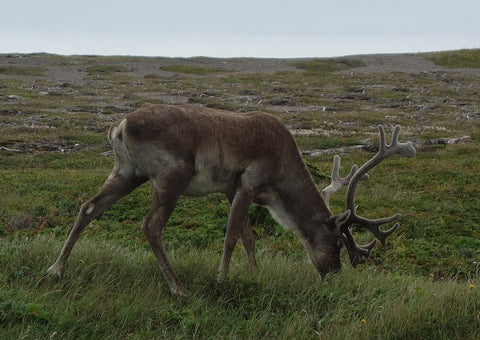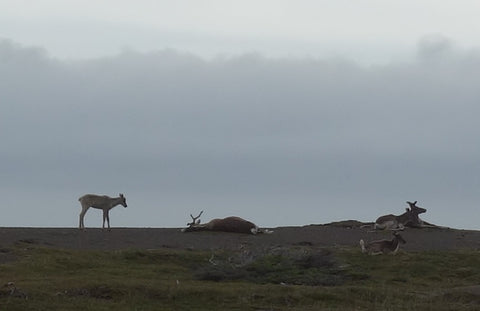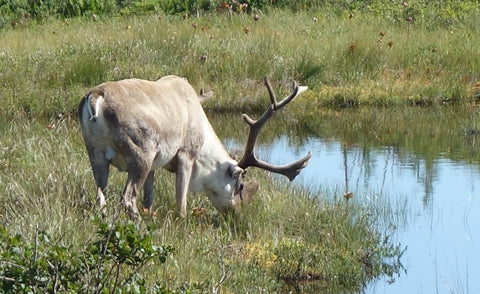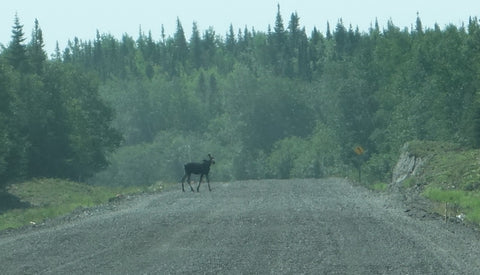Seeing Caribou and Moose in Newfoundland
04 November, 2019 1 comments Leave a comment

This past spring and summer, my husband and I spent 3 months and drove 15,000 km with our truck and trailer, exploring the island of Newfoundland. I took over 2,000 photos of the beautifully rugged scenery and abundant wildlife, distilled to almost 300 paint-able references.
During our journey, we were thrilled to see the sometimes-elusive wildlife for which this province is famous: whales, moose, caribou, and puffins.
In a previous post I shared our whale tales. Today I am presenting our sightings of the four-legged variety.
We spotted caribou herds on two occasions. The first sighting, shown above and below, was at the Port au Choix National Historic Site on the northwest coast.

This small caribou herd is a familiar sight to residents of Port au Choix, roving regularly between the lighthouse on the National Historic Site, through streets and back yards, as far as the Foodland grocery store on the other side of town.

The Port au Choix herd has a mix of bucks and does, with two babies. The youngest one is still white and is pictured standing in the photo below.

The caribou is depicted on Canada's 25-cent coin (shown below).

Our second sighting of caribou was on Hwy 480, which connects Stephenville to the remote port of Burgeo on the south coast of Newfoundland.

The native species of caribou in Newfoundland is named woodland caribou, and numbers about 32,000 animals.

Woodland caribou are a sub-species of reindeer. (Yes, the ones that pull Santa's sleigh.)

I was thrilled to film a few of these magnificent mammals, including one on the highway in front of our truck and trailer. Check out the short video below which shows both sightings described in this article.
Our sightings of moose were more distant ones, for which we actually are thankful. With an island-wide population estimated at 125,000 to 150,000 animals (the highest density of moose in North America), and an average of 700 to 800 moose/vehicle collisions each year, we were OK to see these large animals from afar.

When we left our campground in Kings Point, (which overlooked a saltwater bay full of visiting icebergs and whales), there was an 8 km stretch of gravel road on the way to the trans Canada highway, due to construction. We crawled along at 20 km/h with our 4-way flashers on, to avoid damaging our trailer on the bumpy gravel. Our slow pace allowed for two excellent moose sightings. We spotted a bull beside a pond (shown below) and only a minute later, a cow crossed the highway in front of us (shown above). We were able to stop and get pictures even though the animals were fairly far away.

Their long legs make moose ideally suited to forest living, stepping over logs, negotiating thick brush, and moving through deep snow. Their hooves spread widely, supporting the animal's weight in bogs.
The most interesting moose sighting was at the L'Anse Aux Meadows National Historic Site and UNESCO World Heritage Site. Before our guided tour of the 1000-year-old Viking settlement remains, we spotted this cow moose with twin babies (below).

A few days later, we journeyed onward to Roddickton, which apparently is the moose capital of the world (see photo below). There was a very interesting moose interpretive centre there.
We learned that two breeding pairs of moose were introduced to Newfoundland in 1904 to add variety to the local diet. It is believed the current population is descended entirely from these 4 animals.

But the most fascinating fact we learned about moose is that they are truly at home in water. In fact, they can snap their nostrils shut and dive down 5 metres to feed at the bottom of a pond! Who knew?!
If you have unusual animal sighting stories or other comments to share, please do so using the 'Leave a Comment' button at the top of this post.
Subscribe to Karen's Newsletter for exclusive early access to new work, studio news updates, travel tales, painting tips, and notices of upcoming exhibitions.





Thank you Karen!
What a wonderful experience you had!
Now I know why moose are so often pictured knee deep in water!!!
Neat!